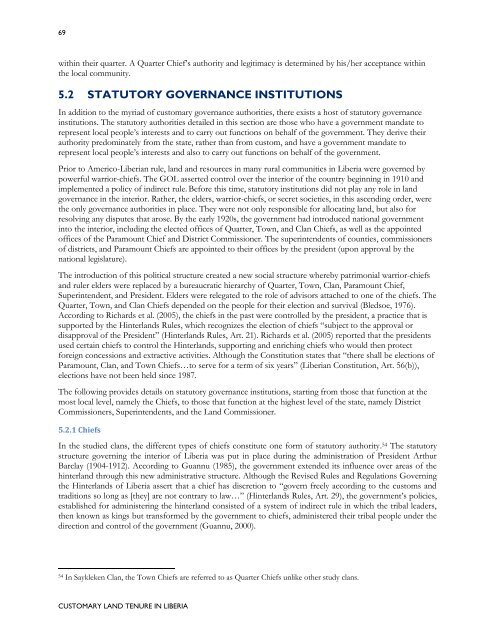Customary Land Tenure in Liberia - Land Tenure and Property ...
Customary Land Tenure in Liberia - Land Tenure and Property ...
Customary Land Tenure in Liberia - Land Tenure and Property ...
Create successful ePaper yourself
Turn your PDF publications into a flip-book with our unique Google optimized e-Paper software.
69<br />
with<strong>in</strong> their quarter. A Quarter Chief‟s authority <strong>and</strong> legitimacy is determ<strong>in</strong>ed by his/her acceptance with<strong>in</strong><br />
the local community.<br />
5.2 STATUTORY GOVERNANCE INSTITUTIONS<br />
In addition to the myriad of customary governance authorities, there exists a host of statutory governance<br />
<strong>in</strong>stitutions. The statutory authorities detailed <strong>in</strong> this section are those who have a government m<strong>and</strong>ate to<br />
represent local people‟s <strong>in</strong>terests <strong>and</strong> to carry out functions on behalf of the government. They derive their<br />
authority predom<strong>in</strong>ately from the state, rather than from custom, <strong>and</strong> have a government m<strong>and</strong>ate to<br />
represent local people‟s <strong>in</strong>terests <strong>and</strong> also to carry out functions on behalf of the government.<br />
Prior to Americo-<strong>Liberia</strong>n rule, l<strong>and</strong> <strong>and</strong> resources <strong>in</strong> many rural communities <strong>in</strong> <strong>Liberia</strong> were governed by<br />
powerful warrior-chiefs. The GOL asserted control over the <strong>in</strong>terior of the country beg<strong>in</strong>n<strong>in</strong>g <strong>in</strong> 1910 <strong>and</strong><br />
implemented a policy of <strong>in</strong>direct rule. Before this time, statutory <strong>in</strong>stitutions did not play any role <strong>in</strong> l<strong>and</strong><br />
governance <strong>in</strong> the <strong>in</strong>terior. Rather, the elders, warrior-chiefs, or secret societies, <strong>in</strong> this ascend<strong>in</strong>g order, were<br />
the only governance authorities <strong>in</strong> place. They were not only responsible for allocat<strong>in</strong>g l<strong>and</strong>, but also for<br />
resolv<strong>in</strong>g any disputes that arose. By the early 1920s, the government had <strong>in</strong>troduced national government<br />
<strong>in</strong>to the <strong>in</strong>terior, <strong>in</strong>clud<strong>in</strong>g the elected offices of Quarter, Town, <strong>and</strong> Clan Chiefs, as well as the appo<strong>in</strong>ted<br />
offices of the Paramount Chief <strong>and</strong> District Commissioner. The super<strong>in</strong>tendents of counties, commissioners<br />
of districts, <strong>and</strong> Paramount Chiefs are appo<strong>in</strong>ted to their offices by the president (upon approval by the<br />
national legislature).<br />
The <strong>in</strong>troduction of this political structure created a new social structure whereby patrimonial warrior-chiefs<br />
<strong>and</strong> ruler elders were replaced by a bureaucratic hierarchy of Quarter, Town, Clan, Paramount Chief,<br />
Super<strong>in</strong>tendent, <strong>and</strong> President. Elders were relegated to the role of advisors attached to one of the chiefs. The<br />
Quarter, Town, <strong>and</strong> Clan Chiefs depended on the people for their election <strong>and</strong> survival (Bledsoe, 1976).<br />
Accord<strong>in</strong>g to Richards et al. (2005), the chiefs <strong>in</strong> the past were controlled by the president, a practice that is<br />
supported by the H<strong>in</strong>terl<strong>and</strong>s Rules, which recognizes the election of chiefs “subject to the approval or<br />
disapproval of the President” (H<strong>in</strong>terl<strong>and</strong>s Rules, Art. 21). Richards et al. (2005) reported that the presidents<br />
used certa<strong>in</strong> chiefs to control the H<strong>in</strong>terl<strong>and</strong>s, support<strong>in</strong>g <strong>and</strong> enrich<strong>in</strong>g chiefs who would then protect<br />
foreign concessions <strong>and</strong> extractive activities. Although the Constitution states that “there shall be elections of<br />
Paramount, Clan, <strong>and</strong> Town Chiefs…to serve for a term of six years” (<strong>Liberia</strong>n Constitution, Art. 56(b)),<br />
elections have not been held s<strong>in</strong>ce 1987.<br />
The follow<strong>in</strong>g provides details on statutory governance <strong>in</strong>stitutions, start<strong>in</strong>g from those that function at the<br />
most local level, namely the Chiefs, to those that function at the highest level of the state, namely District<br />
Commissioners, Super<strong>in</strong>tendents, <strong>and</strong> the <strong>L<strong>and</strong></strong> Commissioner.<br />
5.2.1 Chiefs<br />
In the studied clans, the different types of chiefs constitute one form of statutory authority. 54 The statutory<br />
structure govern<strong>in</strong>g the <strong>in</strong>terior of <strong>Liberia</strong> was put <strong>in</strong> place dur<strong>in</strong>g the adm<strong>in</strong>istration of President Arthur<br />
Barclay (1904-1912). Accord<strong>in</strong>g to Guannu (1985), the government extended its <strong>in</strong>fluence over areas of the<br />
h<strong>in</strong>terl<strong>and</strong> through this new adm<strong>in</strong>istrative structure. Although the Revised Rules <strong>and</strong> Regulations Govern<strong>in</strong>g<br />
the H<strong>in</strong>terl<strong>and</strong>s of <strong>Liberia</strong> assert that a chief has discretion to “govern freely accord<strong>in</strong>g to the customs <strong>and</strong><br />
traditions so long as [they] are not contrary to law…” (H<strong>in</strong>terl<strong>and</strong>s Rules, Art. 29), the government‟s policies,<br />
established for adm<strong>in</strong>ister<strong>in</strong>g the h<strong>in</strong>terl<strong>and</strong> consisted of a system of <strong>in</strong>direct rule <strong>in</strong> which the tribal leaders,<br />
then known as k<strong>in</strong>gs but transformed by the government to chiefs, adm<strong>in</strong>istered their tribal people under the<br />
direction <strong>and</strong> control of the government (Guannu, 2000).<br />
54 In Saykleken Clan, the Town Chiefs are referred to as Quarter Chiefs unlike other study clans.<br />
CUSTOMARY LAND TENURE IN LIBERIA

















